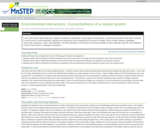
Students and teachers can explore environmental issues with classroom resources, homework help, and other publications.
- Subject:
- Social Studies
- Material Type:
- Reading
- Provider:
- United States Environmental Protection Agency
- Date Added:
- 08/28/2023

Students and teachers can explore environmental issues with classroom resources, homework help, and other publications.

In this jigsaw, students will graph various Bald Eagle population numbers and determine the impact humans have had on the eagle. Specifically, they will investigate why the Bald Eagle was listed as endangered, the affects of DDT on eagles, and the affects of lead. Based on an original activity titled "Bald Eagle Population Graphing" from The Raptor Center, University of Minnesota http://www.cvm.umn.edu/raptor/prod/groups/cvm/@pub/@cvm/documents/asset/cvm_66866.pdf

An introduction to ecosystems with how land ecosystems are classified into biomes. [7:32]
Khan Academy learning modules include a Community space where users can ask questions and seek help from community members. Educators should consult with their Technology administrators to determine the use of Khan Academy learning modules in their classroom. Please review materials from external sites before sharing with students.

Understand the flow of energy and matter through ecosystems and what happens if an ecosystem is disrupted. [8:56]
Khan Academy learning modules include a Community space where users can ask questions and seek help from community members. Educators should consult with their Technology administrators to determine the use of Khan Academy learning modules in their classroom. Please review materials from external sites before sharing with students.

Seeing how energy and matter flows and is recycled from primary producers (autotrophs) to primary, secondary and tertiary consumers. [10:25]
Khan Academy learning modules include a Community space where users can ask questions and seek help from community members. Educators should consult with their Technology administrators to determine the use of Khan Academy learning modules in their classroom. Please review materials from external sites before sharing with students.

Plants are a resource that can help scientists measure change. This webcast digs into how plant specimens are studied to better understand ecosystem changes. [29:14]

This activity is an open-ended inquiry investigation in which students analyze and predict how an environmental change will affect the visitation rates of insects. Students will ask a question, develop multiple hypotheses, run a scientific investigation, and report their findings to their "colleagues".

Students will explore and create a healthy ecosystem, once established they will then introduce additional variables which may harm the ecosystem and determine which hazards should be avoided.

Ecosystems are composed of all interacting organisms (biota) along with their physical and chemical environments. Physical aspects of an ecosystem, called abiotic components, include variables related to temperature, sunlight, soil, and other factors. [33:28]

Slideshow that looks at energy flow in an ecosystem. Explains what an ecosystem is, how energy flows through it, the producers and consumers of energy, and food chains. Links to a video about plastic debris in the ocean.

In this media-rich lesson, students learn how global warming is changing the Alaskan environment and examine the consequences of climate change on the region's human and wildlife inhabitants.

This feature, adapted from Interactive NOVA: "Earth," follows the path of energy as it is transferred via the food chain from one type of organism to another.

This video segment, adapted from NOVA, describes the energy flow in a coral reef, including its food web.

This is a field investigation of how a natural system is organized and the interconnectedness of an ecosystem.

This article aligns the concepts of Essential Principle 2 of the Climate Sciences to the K-5 content standards of the National Science Education Standards. The author also identifies common misconceptions about heat and the greenhouse gases effect and offers resources for assessing students' understanding of interactions among components of the Earth system. This article continues the examination of the climate sciences and climate literacy on which the online magazine Beyond Weather and the Water Cycle is structured.

This article identifies age-appropriate national science education content standards and curriculum connections for introducing complex concepts contained in Principle 7 of the Essential Principles of Climate Sciences. The principle describes consequences of climate changes on Earth systems and human lives. The content standards will help teachers determine appropriate topics for their students. A number of resources from the online magazine Beyond Weather and the Water Cycle are highlighted for their connection to the science curriculum in the early grades. In addition, the article identifies common misconceptions about weather and the water cycle often held by students.

This video segment from NatureScene features the area of the Congaree Swamp where the high ground and the flood plain meet. Learn how a few feet of difference in elevation on a floodplain can yield drastic changes in what you'll find living. [2:35]

This video segment from NatureScene features the area of the Congaree Swamp where the high ground and the flood plain meet. Learn how a few feet of difference in elevation on a floodplain can yield drastic changes in what youŰ__Ű__Çll find living there.

The teacher's guide to the Flooded Classroom Prezi

A guided prezi in which students explore a virtual coastal ecosystem